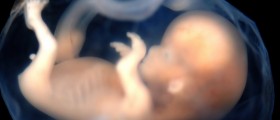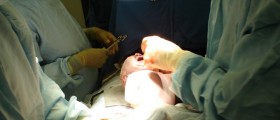
Namely, the pain that occurs in the lower abdomen is more frequent in women than in men which may be explained by conditions that tend to affect various female reproductive organs.
Pelvic Pain is Pain in Abdomen
One of the reasons for the occurrence of right side pelvic pain in women is ectopic pregnancy. It is a type of pregnancy when the fertilized egg does not implant itself in the uterine wall, but somewhere else in the pelvis. It is very important to diagnose ectopic pregnancy on time. Otherwise, the condition can be very dangerous and sometimes even lethal.
The pain in the right side of the pelvis in women may be also triggered by menstrual cramps. Typically, such pain tends to spread to the lower back and the upper abdomen.
Furthermore, when the right ovary, right fallopian tube, and the right side of the uterus are inflamed, this can lead to the ride side pelvic pain. The main causes of these inflammatory diseases are the bacteria that also cause gonorrheal and Chlamydial infections. The additional symptoms of pelvic inflammatory disease, apart from the pain are irregular menstrual bleeding and vaginal discharge.
As far as men are concerned, the most common cause of the occurrence of the right side pelvic pain is prostatitis, which is a medical term for inflammation of the prostate gland. This inflammation can be associated with bacterial or viral infection, and must be treated on time. Otherwise, it can cause serious complications, such as chronic pelvic pain syndrome and chronic bacterial prostatitis.
Irritable bowel syndrome is another cause that can be responsible for the occurrence of the pain in the right side of the lower abdomen in both, men and women. In the majority of cases, the main cause of irritable bowel syndrome is bowel muscle sensitivity. When one suffers from this condition, he/she may experience altering constipation and diarrhea, muscle cramping, and pelvic pain.
Other factors that can lead to the pelvic pain in the right side in men are hemorrhoids and varicoceles, while in women, such pain is connected with the presence of uterine fibroids and ovarian cysts.Abdominal Cysts May be Problematic As Well
A cyst represents encapsulated air, fluid or semi-liquid material. The membrane of the cyst does not allow any contact between its content and surrounding tissues. Cysts may form in each and every part of the body. The majority of cysts are benign and may withdraw spontaneously.
Their size varies a lot and in some cases the grown of the cyst can lead to discomfort, pain or even rupture of the cyst. If the cyst is huge and causes symptoms such as compression of surrounding tissues, pain or there is a great chance it will burst, it is treated surgically. In rather rare cases certain cysts may transform into malignant tumors.Thus, in some cases, abdominal cysts can trigger pelvic pain on the right side of the body.
There are several types of abdominal cysts. Three of them are most common and they include mesenteric abdominal cyst, omental abdominal cyst and fetal abdominal cyst.
Mesenteric abdominal cysts form in the mesentery, a double layer of the peritoneum that covers the back wall of the abdominal cavity and certain organs in the abdomen. The cause of these cysts can be the inadequate functioning of the lymphatic system. Mesenteric cysts are not so common and the incidence of these cysts is slightly higher in children.
Omental abdominal cysts form in the anterior part of the abdomen, predominantly affecting the area of the stomach and the colon. These cysts are also quite rare.
And finally, fetal abdominal cysts are benign cysts which affect infants. They can be diagnosed even while the baby is still in the uterus. Fetal abdominal cyst typically affect female fetus and occur due to increased levels of certain hormones. They withdraw spontaneously after the birth. Surgical removal is required only if they are too big and compromise blood circulation of the infant.
Small cysts are usually detected accidentally during ultrasound of the abdomen. If large in size cysts can cause pressure onto the surrounding tissues and organs which results in discomfort and pain. In some cases cysts can be even palpated, potentially causing bleeding, vomiting, and bloating. Also, there is a possibility of intestinal obstruction as far as abdominal cysts are concerned.
Basically, all of the above mentioned health issues are potential causes of pelvic pain which can affect your right side of the lower abdomen. The causes can range from inflammation, infections and diseases, to different types of abdominal cysts.Thus, if you experience frequent or recurring pain in the right pelvic area, or pelvic area in general, seek medical assistance timely, and have the health issue behind this condition diagnosed and treated.

















Your thoughts on this
Loading...